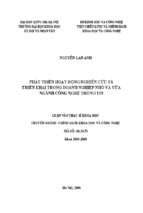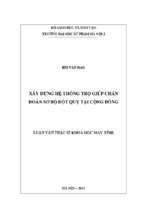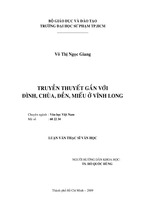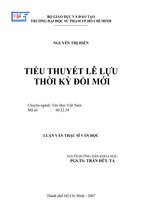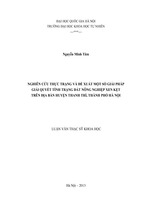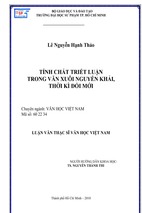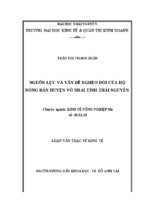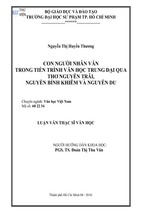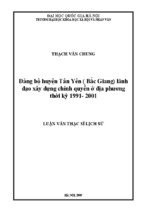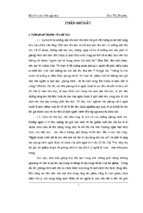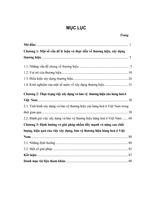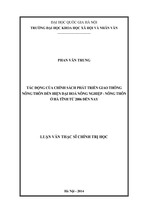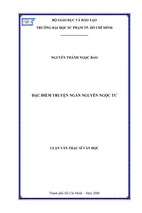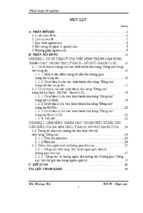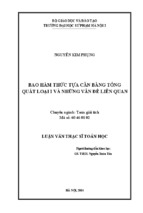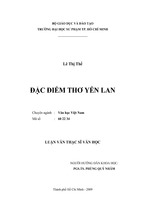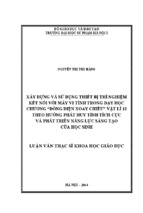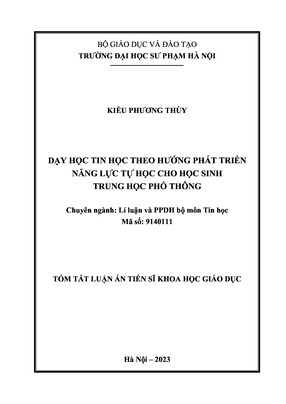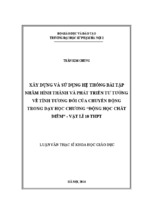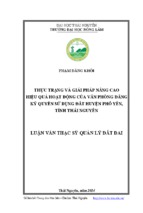The thesis was designed as a comparative and exploratory study of the use of pause in American and Vietnamese political speeches with two major purposes: (1) to investigate the ways discourse pause used in political speeches, (2) to demonstrate the effects of pause in the politician‘s presentations, (3) to explain briefly and subjectively the reasons why there were differences in using pause in two political culture. The selected subject who is representative to the U.S was the president Barack Obama while the Vietnamese one was the prime minister Nguyễn Tấn Dũng. Data for this study were collected from two videos recording the two politician‘s inaugural ceremonies. The main method applied to conduct this thesis was observation. To draw on the major similarities and differences between two politicians in using pause, the researcher observed the videos and counted the numbers of pauses and their durations. The durations were divided into three groups: short (1-3 seconds), medium (4-7 seconds), long ( >8 seconds). The collected data were analyzed in terms of the frequency of pauses, the durations of pause, and the effects of pauses. The results show that Barack Obama used pause more frequently than Nguyễn Tấn Dũng did. The amount of time he paused was also longer than that of Nguyễn Tấn Dũng. The reactions of the audiences in each case were also different. Yelling and, clapping hands were generally common reactions the audiences had each time Obama used silence while quietness and hand-clapping at the end of the speech were the responses of the Vietnamsese audiences. The reasons why two politicians used pauses so differently were subjectively concluded to be the atmosphere, the cultural norms: high-context culture and low-context culture, and the supported technology by the reseacher.
VIETNAM NATIONAL UNIVERSITY, HANOI
UNIVERSITY OF LANGUAGES AND INTERNATIONAL STUDIES
FACULTY OF ENGLISH LANGUAGE TEACHER EDUCATION
GRADUATION PAPER
A CASE STUDY OF DISCOURSE PAUSE USED IN 2013
INAUGURAL SPEECH BY THE U.S PRESIDENT BARACK
OBAMA AND IN 2011 INAUGURAL SPEECH BY THE
VIETNAMESE PRIME MINISTER NGUYEN TAN DUNG.
(FROM A PERSPECTIVE OF CROSS-CULTURAL PRAGMATICS)
Supervisor: Ngô Hữu Hoàng, PhD.
Student: Bùi Thị Hằng Nga
Course: QH2010.F1.E15
HÀ NỘI - 2014
ĐẠI HỌC QUỐC GIA HÀ NỘI
TRƯỜNG ĐẠI HỌC NGOẠI NGỮ
KHOA SƯ PHẠM TIẾNG ANH
KHÓA LUẬN TỐT NGHIỆP
MỘT ĐIỂN CỨU VỀ SỰ NGỪNG NGHỈ DIỄN NGÔN
TRONG HAI BÀI DIỄN VĂN NHẬM CHỨC NĂM
2013 CỦA TỔNG THỐNG BARACK OBAMA VÀ 2011
CỦA THỦ TƯỚNG NGUYỄN TẤN DŨNG.
(XÉT TỪ GÓC ĐỘ DỤNG HỌC GIAO VĂN HÓA)
Giáo viên hướng dẫn: Ts. Ngô Hữu Hoàng
Sinh viên: Bùi Thị Hằng Nga
Khóa: QH2010.F1.E15
HÀ NỘI - 2014
ACKNOWLEDGEMENTS
First of all, I would like to express a special thanks to all of my teachers who
gave me a general background knowledge about walk of life, researching method
and cross-culture, especially PhD. Ngô Hữu Hoàng who is adviser, for helping and
coaching me by answering all my questions concerning my topic.
Second, I would also like to thanks to all of my friends who are always
standing by my side no matter what happen, especially Ms. Trường- ―my
granddaughter in brackets‖ and Ms. Lan who gave me her reliability and
encouragement.
Finally, I want to thank my family members who were always my supports
in the moment when there was no one to answer my queries. No word can express
my deepest gratefulness to my dad and my mom who have brought me up with love
and affections. I also want to thank to my sister, and brother who helped me with
housework and encouraged me in studying.
Bùi Thị Hằng Nga
i
ABSTRACT
The thesis was designed as a comparative and exploratory study of the use of
pause in American and Vietnamese political speeches with two major purposes: (1)
to investigate the ways discourse pause used in political speeches, (2) to
demonstrate the effects of pause in the politician‘s presentations, (3) to explain
briefly and subjectively the reasons why there were differences in using pause in
two political culture.
The selected subject who is representative to the U.S was the president
Barack Obama while the Vietnamese one was the prime minister Nguyễn Tấn
Dũng. Data for this study were collected from two videos recording the two
politician‘s inaugural ceremonies. The main method applied to conduct this thesis
was observation. To draw on the major similarities and differences between two
politicians in using pause, the researcher observed the videos and counted the
numbers of pauses and their durations. The durations were divided into three
groups: short (1-3 seconds), medium (4-7 seconds), long ( >8 seconds). The
collected data were analyzed in terms of the frequency of pauses, the durations of
pause, and the effects of pauses.
The results show that Barack Obama used pause more frequently than
Nguyễn Tấn Dũng did. The amount of time he paused was also longer than that of
Nguyễn Tấn Dũng. The reactions of the audiences in each case were also different.
Yelling and, clapping hands were generally common reactions the audiences had
each time Obama used silence while quietness and hand-clapping at the end of the
speech were the responses of the Vietnamsese audiences. The reasons why two
politicians used pauses so differently were subjectively concluded to be the
atmosphere, the cultural norms: high-context culture and low-context culture, and
the supported technology by the reseacher.
ii
TABLE OF CONTENTS
ACKNOWLEDGEMENTS......................................................................................i
ABSTRACT...............................................................................................................ii
TABLE OF CONTENTS........................................................................................iii
LIST OF TABLES....................................................................................................v
INTRODUCTION
I.
Rationale for the study..................................................................................1
II.
Aims and objectives.......................................................................................2
III.
Significance of the study................................................................................3
IV.
Scope of the study...........................................................................................3
V.
Organization...................................................................................................4
DEVELOPMENT
CHAPTER 1: THEORETICAL BACKGROUND...............................................5
1.1.
Discourse.........................................................................................................5
1.2.
Non-verbal communication...........................................................................7
1.2.1. Paralanguage...................................................................................................8
1.2.2. Pause/Silence in Discourse............................................................................10
1.2.2.1.
Definition and classification...............................................................10
1.2.2.2.
Pause functions...................................................................................11
1.2.3. Pauses situations in monologue.....................................................................13
1.3.
Low context culture and high context culture...........................................15
1.3.1. Definition and comparisons...........................................................................15
1.3.2. High-context and low-context culture in relationship with pauses in
discourse...................................................................................................................20
CHAPTER 2: METHODOLOGY.........................................................................22
2.1. Selection of subject...........................................................................................22
2.2. Research instrument........................................................................................23
2.3. Procedures of data collection..........................................................................23
2.4. Procedures of data analysis.............................................................................24
CHAPTER 3: THE STUDY...................................................................................26
iii
3.1. Frequency of pauses and its duration............................................................26
3.2. Pause effects......................................................................................................30
3.3. The reasons of the difference in using pauses of two politicians.................35
3.3.1. The difference in atmosphere..........................................................................35
3.3.2. Cultural norm..................................................................................................37
CHAPTER 4: CONCLUSION...............................................................................39
I.
Summary of findings....................................................................................39
II.
Limitation.....................................................................................................40
III.
Suggestions for further study......................................................................40
REFERENCES........................................................................................................41
APPENDIX..............................................................................................................45
iv
LIST OF TABLES AND IMAGES
1.
List of tables
Table
1
2
2.
Name
Frequency of pauses and its duration
Summarized effects of pause in each case
Page number
27
31
List of images
Image
1
Name
The reactions of audiences during the time Obama
used pause
Page number
33
2
Obama‘s emotion
35
3
The overall view of Obama‘s ceremony
36
4
The Vietnamese parliamentary auditorium.
37
5
Teleprompter- a display device that prompts the
38
person speaking with an electronic visual text of a
speech or script.
v
INTRODUCTION
I.
RATIONALE
Pause in discourse across cultures is catalogued as one of the branches of
paralanguage which play an important role in communication. It is undoubted
that there is strong power in pausing in communication. Thus, everyone should
pay more attendance to discourse pause. For example, someone else may not
have finished their thought and you may not want to cut them off. Cutting
someone off too soon may cause you to miss some important information to be
shared. Another reason to pause is to avoid making mistakes during speaking that
are not fully formulated in your mind. When in a heated discussion, pausing can
help avoid overreacting or exacerbating a situation. Pausing can give you an
opportunity in person to consider the body language and other signals being
given by those around you. If you are giving a presentation, providing training or
an explanation of important information, pausing can help your audience keep up
with you and have time to absorb important details. Pause exists in all social
interactions in any culture; however, the way people use pauses is not the same in
different language and cultures. The thesis is conducted to make this clearer.
Besides, the globalization brings us a chance to communicate more widely
not only in such fields as economics, society and culture but also in politics.
Many conferences are now being held with the participants of politicians from
many countries-different cultures. What will happen if a politician from a
country uses pause in his/ her speech? The other politicians will be surprised
meaninglessly or understand that they need to make some responses to the
speaker showing their emotions or their willingness of listening. Moreover, the
relationships between Vietnam and the western countries are enhanced. There are
now more official visits from the delegates of these countries to our country,
particularly the United States.
Moreover, the selected subjects are famous people, particularly Barack
Obama- the first black president of the United States. With his background,
Barack Obama is considered as a multi-cultural person. Furthermore, Barack
6
Obama is believed as ―a gifted speaker who has something to teach all leaders in
business and politics, regardless of their political opinions‖ by the contributor
Carmine Gallo in his 2012 essay in Forbes Magazine named ― Barack Obama-A
master class in public speaking‖. Carmine Gallo also commented that Obama
was an expert in using voice. He slowed it down, lowered or loudened it, and
especially paused for impact (Gallo, 2012). After watching several speeches
conducted by Barack Obama, the researcher recognized that one of the special
features of his all speeches, particularly in the 2013 inaugural speech, was the use
of pause with clear purposes. This, to some extents, illustrated the specific
features of American culture and society. Additionally, learning from the famous
people like Barack Obama and Nguyễn Tấn Dũng is much easier than learning
from a book
All in all, considering the benefits of using pause effectively as well as
anticipating the consequences of lacking understanding of it in communication in
general, and in politics in particular, the researcher wants to conduct a study
about this field not only to help people, particularly students, seize the benefits of
using pause in communicating and avoid the misunderstanding, but also to bring
about the differences of using discourse pause in two culture and political
background.
II.
AIMS OF THE STUDY
As stated in the above part, the researcher conducts this study to illustrate
the similarities and differences regarding political culture in using discourse
pauses by Barack Obama in comparison with Nguyễn Tấn Dũng. From this main
purposes, the author has had these research questions:
-
What is the way Barack Obama used discourse pause in his
2013 inaugural speech?
-
What is the way Nguyễn Tấn Dũng used discourse pause in
his 2011 inaugural speech?
-
To what extents their discourse pauses affect the audiences?
7
-
What can cause the differences in using discourse pause of
two politicians?
III.
SIGNIFICANCE OF THE STUDY
This thesis helps the researcher gain more knowledge about not only
culture but also the use of discourse in cultures. The study also evokes the desire
of learning and experiencing from the researcher. Since then, the researcher has
an opportunity to broaden her knowledge about cultures in the world, especially
American and Vietnamese cultures which will definitely be a vital knowledge for
her in the future when globalization is more and more prevalent.
The recognition of similarities and differences between discourse and
culture will help the researcher find out the way of communicating properly and
appropriately to improve her communication skills.
As to students, the thesis may provide a fresh and unique approach about
culture in general, and discourse pause in particular. Students will find it as an
interesting way to absorb the knowledge as well as achieve the extra information
which is out of the text book.
Regarding the politicians, the study may bring about a new view about
presentation. Politicians may have a different opinion about the way to deliver a
speech as well as be aware of the effects of non-verbal communication and
discourse pauses.
IV.
SCOPE OF THE STUDY
The thesis only focuses on pause which is one of the branches of
paralanguage and its surrounding issues in the political culture, not on all the
categories of non-verbal communication. The researcher just concentrates on
analyzing the two inaugural speeches of the two politicians: Barack Obama and
Nguyễn Tấn Dũng as objects of the study.
The researcher bases on the perspective of cross-cultural pragmatics to
evaluate the similarities and differences regarding political culture in using
discourse pauses by Barack Obama in comparison with Nguyễn Tấn Dũng. The
8
researcher also uses the theoretical background about high-context and lowcontext culture to assess the way the politicians used pauses.
V.
ORGANIZATION
The study consists of three main parts:
-
Introduction, which provides the rationale, scope, aims, and
methods of the study.
-
Development, which covers three chapters:
Chapter 1: Theoretical Background. This chapter provides the
knowledge about non-verbal communication, paralanguage, discourse, pause,
high-context and low-context culture.
Chapter 2: Methodology. In this chapter, the researcher presents
the definition of the methods used to conduct the thesis. The steps to collect the
data and analyze the data are described clearly in this chapter.
Chapter 3: The study. The differences in using pauses between
two politicians, pauses effects and the reasons for the differences are clarified in
this chapter.
Chapter 4: Conclusion. In this chapter, the researcher summarizes
the findings, points out the limitations of the thesis, and gives the suggestions for
further research offered.
9
DEVELOPMENT
CHAPTER 1
THEORETICAL BACKGROUND
1.1.
Discourse.
Up to now, discourse remained to be the subject of heated debates.
Discourse is considered as a key notion in a lot of current works in the social
science and its meaning varies according to the particular theorists. For example,
in the book called ― A dictionary of Linguistics and Phonetics‖, Crystal argued
that discourse is often used to refer to a stretch of language- spoken and writtenin context ( Crystal, 1997). Besides, among many social theorists, notably poststructuralist social philosophers, Foucault believed that discourse is involved in
socially and historically situated domains of knowledge or ways of interpreting
the world ( Foucault, 1980). However, there are two main notions of discourse
which are popularly used to talk about language in context.
-
Discourse is defined as “language in its social context, as it is used
to carry out the social and intellectual life of a community” (Mercer, 1995, p.
79). This meaning of discourse emphasizes the importance of looking at
language in context and usually involves an analysis of actual stretches of spoken
and written language, often referred to as ‗texts‘.
-
Discourse is regarded as “different ways of structuring areas of
knowledge and social practice” (Fairclough, 1992). It is not used to refer to
particular texts, but rather to explain how certain ideas and values are embodied
in the communications of a community or society. Discourse in this sense cannot
be observed or recorded but is rather a theory of social reality. It is commonly
used in analyses of political influence and social power.
Discourse
includes
both
verbal
communication
and
non-verbal
communication. In this thesis, the researcher concentrates on discourse pause
which is a minor branch of paralanguage in non-verbal communication. Besides,
discourse is discovered to have five main elements which are illustrated below:
10
-
Purpose: the foundation of the discourse. What is the aim of a piece of
writing or a stretch of language? For example they use it to explain, to
narrate, to inform, to persuade, to entertain.
-
Speaker: who will be the person who tells the story or says the stretch of
language?
-
Audience: who will be the person who receive the information or the
story?
-
Form: how is the information delivered?
-
Content: what is the actual information be told?
To make a successful conversation, people should consider all of these
elements of discourse.
Additionally, intonation is also considered as one of the elements of
discourse. The term intonation refers to a mean of conveying information in
speech which is independent of the words and their sounds. Central to intonation
is the modulation of pitch, and intonation is often thought of as the use of pitch
over the domain of the utterance. However, the patterning of pitch in speech is so
closely bound to patterns of timing and loudness, and sometimes voice quality,
that we cannot consider pitch in isolation from these other dimensions. The
interaction of intonation and stress - the patterns of relative prominence which
characterize an utterance - is particularly close in many languages, including
English. For those who prefer to reserve ‗intonation‘ for pitch effects in speech,
the word ‗prosody‘ is convenient as a more general term to include patterns of
pitch, timing, loudness, and (sometimes) voice quality (Nolan, 2006).
Intonation is used to carry a variety of different kinds of information. It
signals grammatical structure, though not in a one-to-one way; whilst the end of
a complete intonation pattern will normally coincide with the end of a
grammatical structure such as a sentence or clause, even quite major grammatical
boundaries may lack intonation marking, particularly if the speech is fast.
Intonation can reflect the information structure of an utterance, highlighting
constituents of importance. Intonation can particularly indicate discourse
11
function; for instance most people are aware that saying ― this is John‘s bag‖
with one kind of intonation as a statement, but with another as a question.
Intonation can be used by a speaker to convey an attitude such as friendliness,
enthusiasm, or hostility; and listeners can use intonation-related phenomena in
the voice to make inferences about a speaker‘s state, including excitement,
depression, and tiredness (Nolan, 2006). For example, when someone is asked ―
how is this dress?‖ and he/ she answer: ―L-O-V-E-L-Y‖ with a longer sound
which means he/ she doesn‘t like this dress.
1.2.
Non-verbal communication
Communication is perceived as the transfer of information, ideas and
emotions from one person to another. People spend about 75% of walking hours
sharing the knowledge, thought, and ideas to others. However, it seems that most
of us fail to realize that a great deal of our communication is of a non-verbal
form.
The fact remains that there has been a substantial soar in research and
interest in the phenomena of nonverbal communication during the decade. In its
narrow and accurate sense, nonverbal behavior refers to actions as distinct from
speech. Nonverbal elements consist of facial expression, paralanguage, hand and
arm gestures, postures, positions, and various movements of the body or the legs
and feet. It may also include the way we wear our clothes or the silence we keep.
Albert Mehrabian (1972) once states in his book, namely Nonverbal
communication, that nonverbal communication is the act of imparting or
interchanging thoughts, opinions, or information without the use of spoken
words. Non-verbal communication is used as a key variable to determine
people‘s attitudes, values, and beliefs. For example, an observer watching a focus
group will pay special attention to the nonverbal cues of group interaction, such
as body language, facial expressions, and eyes contact, to identify group
member‘s true feelings about an issue.( Mehranbian, 1972)
According to The New Dictionary of Cultural Literacy (2005), nonverbal
communication is defined as communication without the use of spoken language.
12
In addition, Wikipedia‘s editors indicate that nonverbal communication is usually
understood as the process of communication through sending and receiving
wordless messages. Nonverbal communication can be illustrated through
gestures and touch, by body language or posture, by facial expressions and eyes
contact. In addition, it can be communicate through object communication such
as clothing, hairstyles or even architecture, symbols and inforgraphics. Speech
contains nonverbal elements known as paralanguage, including voice quality,
emotion and speaking style, as well as prosodic features such as rhythm,
intonation and stress ( Wikipedia, 2012).
Nguyen Quang (2008) also defines nonverbal communication as all the
constituents of communication which are not verbally coded, but vocally and/or
non-vocally channeled. It includes paralanguage (nonverbal- vocal) such as:
speed, volume, vocal flow, and extra- language such as gestures, postures, facial
expressions, object language such as clothes, jewelry, and environmental
language as conversational distance, setting.
The proverb ― Actions speak louder than words‖ underscores the
importance of nonverbal communication. Nonverbal communication is especially
significant in cross- cultural situation; however people in different culture adopt
different nonverbal behaviors. The lack of knowledge about nonverbal
communication can cause misunderstandings or culture shock. It seems that
nonverbal communication differences account for typical difficulties in
communication.
1.2.1. Paralanguage
Paralanguage
refers
to
the
vocal
and
nonverbal
elements
of
communication used to modify meaning and convey emotion. Paralanguage may
be expressed consciously or unconsciously, and it includes the pitch, volume,
and, in some cases, the intonation of the speech. Sometimes, the definition is
restricted to vocally- produced sounds. The study of paralanguage is known as
paralinguistic.(Wikipedia)
13
The term ― paralanguage‖ is sometimes used as a cover term for body
language, which is not necessarily tied to speech, and paralinguistic phenomena
in speech, the latter are phenomena that can be observed in speech but that do not
belong to the arbitrary conventional code of language.
As I illustrated above, paralanguage is part of the nonverbal
communication and convey emotions and attitudes. It may not only be expressed
consciously or unconsciously but also include vocalizations such as hissing,
hushing, and whistling, as well as speech modifications such as quality of voice
or hesitations and speed in talking. Some examples of paralanguage are laughing,
crying, whispering, snoring, sucking, sneezing, sighing, etc. Tone of voice plays
a fundamental role in telephone interactions (Wikipedia)
Stephen P. Robbins (1998) states in their book, called Organization
Behavior:
Concepts,
Controversies,
Applications,
that
paralanguage
is
communication that goes beyond the specific spoken words. It includes pitch,
amplitude, rate, and voice quality of speech. Paralanguage reminds us that people
convey their feelings not only in what they, but also in how they say it (Robbins,
1998).
It can come to conclude that the paralinguistic properties of speech play an
important role in human speech communication. According to Wikipedia, there
are no utterances or speech signals that lack paralinguistic properties, since
speech requires the presence of a voice that can be modulated. This voice must
have some properties, and all the properties of a voice as such are paralinguistic.
However, the distinction between linguistics and paralinguistic applies not only
to speech but to writing and sign language as well, and it is not bound to any
sensory modality. Even vocal language has some paralinguistic as well as
linguistic properties that can be seen and even felt.( Wikipedia).
In text-only communication such as email, chatting rooms and instant
messaging, paralinguistic elements can be displayed by emoticons, font and color
choices, capitalization and the use of non-alphabetic or abstract characters.
14
Nonetheless, paralanguage in written communication is limited in comparison
with face-to-face conversation, even sometimes leading to misunderstandings.
1.2.2. Pause/ Silence
1.2.2.1.
Definition and classification
According to Clark (1996), pauses are powerful cues or what is happening
in a conversation. To use them as a basic for analyzing culture-specific behavior,
we first have to check carefully what purposes pauses may serve in conversations
and how the usage differs across cultures. As we want to build a computational
model for American English and Vietnamese, those two cultures are of special
interest.
According to a study about ―Pausing strategies in discourse in Dutch‖
conducted by Monique E. van Donzel and Florien J. Koopmans-van Beinum,
there are basically three different kinds of pausing used by the speakers, which
are operationalized in the following way.
-
―Silent pauses:- breathing pauses included, characterised by a total
absence of speech. A pause was labeled as a silent pause if its
duration was at least 150 msec. This minimal length was to insure
that closure times of stop consonants were not included. In case the
closure time occasionally did exceed 150 msec, it was obviously not
marked as a silent pause.
-
Filled pauses. A hesitation sound (`eeh') was labeled as a filled
pause. These elements in the discourse do not have any lexical
meaning, but they can indicate that the speaker needs time to plan
the continuation of his/her telling, that he/she wants to avoid a
silence, or that he/she wants to `hold the floor'. Silences preceding
and/or following the hesitation sound were marked as 'silence to a
filled pause' (thus not as a silent pause), even if they were shorter
than 150 msec.
-
Lengthening. A speaker can use lengthening as a planning tool by
sustaining a particular vowel or consonant within certain words. As
15
a first step the words containing lengthening were determined by
ear by the first author, and in a later stage checked by the second
author. Two kinds of lengthening were observed: a schwa added
after the last consonant of the word, and the lengthening of a wordinternal vowel or a consonant.”(Donzel & Beinum, 1999)
However, in this thesis, the researcher only concentrates on silent pauses which
are mostly used by the two politicians in their speeches.
1.2.2.2.
Pause functions
In the book of Conversational organization- Interaction between speakers
and hearers, Charles Goodwin (1981) describes his research on gaze behavior
and manipulation. According to Goodwin, gaze is used to manage turn talking
and to signal understanding or attentiveness. If attention signals of the hearer are
missing, pause are used by the speaker to regain attention. In this case the
duration of the pause is dependent from the nonverbal signal of the hearer. Pause/
Silence in speech can be used for the following purposes:
Cognitive processing
Control mechanism
Acceptance/ refusal
Turn taking
(Goodwin, 1981)
It was stated in the book ―The Significance of Pauses in Spontaneous
Speech‖, conducted by Rochester (1973) that pauses are also considered to have
three main functions which are signaling some word choices, reflecting decisions
at major constituent boundaries, and sematic decision-making. The matter of
content and the function of pauses for the speaker are examined. Until that point,
the speaker is simply a language generator which pauses either in the course of
normal decision-making operations or because of disruptions in those operations.
However, the speaker can be seen as a participant in the social act of speech. He
16
also claimed that ―Pause and other phenomena of spontaneous speech should be
functionally related to changes in the interpersonal situation and/ or to changes
in the responsiveness of the speaker, given a constant interpersonal situation‖
(Rochester, 1973).
In addition, according to Rochester, the functional significance of pauses
is considered in terms of cognitive affective-state, and social interaction
variables. Two sorts of social interaction variables are found to influence pauses
in spontaneous speech:
Mediating variables.
Control variables.
In his work, pauses in speech can either be used as control mechanism to
control the flow of the conversation, as well as for cognitive processes, and
decision making (Rochester, 1973).
According to the book ―Politeness: Some universals in language use”
written by Brown and Levinson (1987), politeness strategies are constituted as an
aspect of social interaction. The authors describe some parallelisms in the
linguistic construction of utterances with which people express themselves in
different languages and cultures. One motive of these parallels is isolatedpoliteness. They claim the existence of conversational structure sequences and
with it the intentional usage of pauses for politeness purposes. A careful located
pause can on the one hand mean acceptance and on the other hand refusal.
Moreover, the other common usage of pauses in conversations is to initiate turntaking behavior. It is one of the basic mechanisms in all types of dialogues and
that is also a crucial mechanism in human system interaction. Brown and
Levinson also give an example about pause showing acceptance.
A: Do you sing?
W: (silence)
A: Hooray! Give us a song.
17
In contrast, pause in this case can also be understood as a polite refusal if
the conversers are not observant. Or in a situation, where A asks B for a favor
and B falls into silence, pause is considered as a polite refusal. Therefore, pause
can be used as a polite refusal or acceptance. However, the interpretation of the
pause remains a challenge to the speakers/ listeners. Sometimes, pauses can
cause the misunderstanding between the listeners and the speakers.
1.2.3. Pauses situations in monologue
There are a lot of cases that people can use pause to make their speeches
successful. For example, in the speech ― I have a dream‖ in 1963, Martin Luther
King Junior used pauses effectively and made it as one of his most famous
speeches. Let‘s look at the way he used pauses which were analyzed by Susan
Dugdale in her essay ― Quick and Easy Tips for Using Pauses‖ in the magazine
Write out loud.
“This will be the day when all of God's children will be able to sing with a
new meaning,”
(Pause for breath and for emphasis. He was starting to quote something
important. Give the audience time to anticipate the new meaning.)
"My country,”
(Pause, brief-just enough to underline the importance of 'my country')
“tis of thee,”
(Pause, brief- just enough to underline 'thee')
“sweet land of liberty,”
(Pause- brief to underline 'liberty')
“of thee I sing.”
(Pause for breath and to give the audience time to take in the whole
meaning of the previous phrases.)
“Land where my fathers died,”
18
- Xem thêm -

